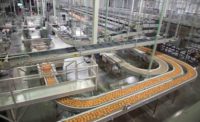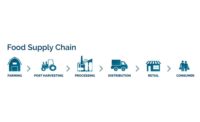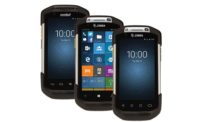Advances in cold chain technology for snack and bakery warehousing and transport
Cold chain technology continues to grow more sophisticated in the face of increased demand for traceability




It’s important to be able to trace the movements of a product or ingredient that requires refrigerated or frozen transport or storage throughout its life cycle, and this is where cold chain technology comes into play.
Advanced devices
“Heightened awareness of foodborne illness as a serious public health problem has led to an increase in demand for monitoring technology to detect when cold storage temperatures fall out of the safe range and to notify designated personnel immediately,” says Rob Fusco, director of business development, Sensaphone, Ashton, PA.
Because FDA urges documenting refrigerator and freezer temperatures along the cold chain, Sensaphone recommends using a monitoring system that includes a data logger—an electronic device that communicates with the sensors to record their data over time.
“A cloud-based monitoring system with an associated app lets users store unlimited amounts of data and access it any time on a smartphone, tablet or computer. This data is no longer subject to human error, as it is with manual tracking and recording, and it is protected by higher-level security protocols,” says Fusco.
The GO Real-Time Trackers from Emerson, St. Louis, have helped redefine when perishable product monitoring is performed in the supply chain by implementing IoT/cellular-capable products, says Amy Childress, vice president of marketing and planning, cargo solutions. “We’ve also supplemented our real-time capabilities with our suite of GO Loggers. In a small and innovative label format, these units combine functionality, quality, design and overall value in a compact temperature recorder.”
Emerson Cargo Solutions has released several new IoT products and services, including the GO Real-Time Reusable Tracker, GO Real-Time Secure Tracker, GO Real-Time CO2 Tracker, and Oversight Exchange Data Integration.
ORBCOMM, Rochelle Park, NJ, also uses IoT technology to support distribution of chilled and frozen products, including baked goods and snacks. Its latest is the CT 3000 series of wireless monitoring devices for refrigerated intermodal shipping containers, says Sue Rutherford, vice president, marketing. These new cellular telematics devices work together with a cloud-based monitoring and control portal to provide remote visibility to the condition of containerized perishable products along the supply chain, with two-way functionality to automatically adjust temperature and other key settings.
“The CT 3000 fits on any major refrigerated container currently available on the market and is permanently attached via screws. The CT 3100 is a magnet-mounted external device that can be installed within seconds and then removed at any point in the chain where the container changes custody,” says Rutherford. “The key differentiator offered by the new product series is the ability for temporary, single-trip container management, enabling remote visibility and control for multiple parties involved in the container cold supply chain.”
Cole-Parmer, Vernon Hills, IL, offers its Digi-Sense Data Loggers with TraceableGO Bluetooth capability, which are ideal for keeping temperature and humidity at set parameters during transport, says Mary Vessele, product marketing manager, test and measurement.
“The data loggers can store up to 90 alarm events,” says Vessele. “Data logger owners can also subscribe to our cloud-based TraceableLive service to upload data from the cloud—ideal for tracking data from multiple loggers or to comply with regulatory agency requirements.”
Cole-Parmer also offers its Digi-Sense TraceableOne Single-Use USB Temperature Data Logger with calibration to ensure effective cold chain management with the one button plug-and-play, says Vessele. “Each single-use data logger is traceable to NIST standards. These one-time use data loggers are pre-programmed to measure typical temperature ranges of interest with alarm set-points that allow a quick check for outliers. The data loggers auto-generate PDFs when plugged into a computer, and no software or driver is required for set-up or download data.”
BluLine Solutions, Pittsburgh, has launched a new RF long-range temperature data logger that can run in a dual mode of live continuous temperature monitoring and delayed temperature data broadcasting, says Ted Wilkes, director of business development.
“This is ideal for applications in the cold storage warehouse or refrigerated transport vehicles that want live monitoring where the RF logger has access to the internet for immediate reporting,” says Wilkes. “For applications where internet access is not available, such as many refrigerated vehicles that distribute products, the RF loggers will capture temperature data while the refrigerated vehicle is delivering product. Then, when it returns back to the warehouse or loading dock, it will autonomously download all the temperature data it measured during product distribution to the internet using the connected gateway hub at the warehouse.” An included cloud-connected dashboard then helps manage all temperature data for live monitoring of warehouses and refrigerated vehicles, as well as any third-party logistics that use the Blulog NFC temperature data logger. “This eliminates the need of companies to build their own software and manage server storage for lifelong temperature data.”
Clear indicators
American Thermal Instruments (ATI), Dayton, OH, recently launched a printable ink technology with its partner, Chromatic Technologies, Inc. The ink turns from white to blue when the product has been exposed to freezing temperatures, says Carissa Smith, marketing director. “We are noticing a rapid growth in temperature monitoring at the product level versus the pallet or truckload level. This reduces end cost, by allowing companies to sort through product and test or discard those exposed to critical temperatures versus disposing of the entire shipment.”
ATI has also released a Bluetooth logger. “The ATI devices are unique due to their long read range of up to 40 meters,” remarks Smith. This means the temperature data can be pulled without taking apart the pallet or opening the box. Data can be pulled at various points of shipping or storage and pushed directly into a logistics or quality system.
ATI also recently launched Endicate, an electronic time/temperature indicator. “This device is easily configured with up to four time and temperature alarms,” explains Smith.
SpotSee, Dallas, offers one-use indicators such as SpotSee’s WarmMark or ColdMark that are irreversible, visual indicators that prove whether or not a temperature deviation has occurred, says Bruce Gaydos, director of sales for North America. “These indicators are best used for last-mile deliveries.”
SpotSee also offers SpotBot Cellular recorders, which send an alert straight to a phone or computer at specific temperature threshold violations. Alternatively, the waterproof LOGIC Temperature Recorder downloads its data after delivery. “Trip data is viewable and printable through an unalterable PDF file,” says Gaydos.
Another benefit of using digital recorders is that workers are held more accountable for their actions and are less likely to be negligent when handling monitored products. This, on top of the additional transparency, allows users to locate and fix recurring issues, suggests Gaydos. “Identifying problem points in the cold chain is vital to selling consistent, high-quality products and increasing efficiency. The demand for a more-transparent supply and cold chain is always increasing, and offering devices that can provide that in a variety of ways and price points means it is more accessible than ever.”
For a look into some of the top challenges snack producers and bakeries face when working with the cold chain, see "Tackling cold chain challenges with improved technology."
Looking for a reprint of this article?
From high-res PDFs to custom plaques, order your copy today!











